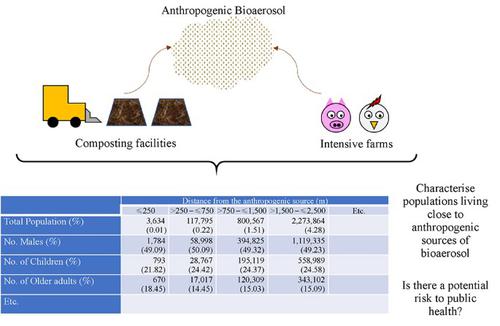Frontiers of Environmental Science & Engineering ( IF 6.1 ) Pub Date : 2020-11-04 , DOI: 10.1007/s11783-020-1332-z Philippa Douglas , Daniela Fecht , Deborah Jarvis

|
Bioaerosol exposure has been linked to adverse respiratory conditions. Intensive farming and composting facilities are important anthropogenic sources of bioaerosols. We aimed to characterise populations living close to intensive farming and composting facilities. We also infer whether the public are becoming more concerned about anthropogenic bioaerosol emissions, using reports of air pollution related incidents attributed to facilities. We mapped the location of 1,257 intensive farming and 310 composting facilities in England in relation to the resident population and its characteristics (sex and age), area characteristics (deprivation proxy and rural/urban classification) and school locations stratified by pre-defined distance bands from these bioaerosol sources. We also calculated the average number of air pollution related incidents per year per facility. We found that more than 16% of the population and 15% of schools are located within 4,828 m of an intensive farming facility or 4,000 m of a composting facility; few people (0.01 %) live very close to these sites and tend to be older people. Close to composting facilities, populations are more likely to be urban and more deprived. The number of incidents were attributed to a small proportion of facilities; population characteristics around these facilities were similar. Results indicate that populations living near composting facilities (particularly>250 to ⩽ 4,000 m) are mostly located in urban areas (80%–88% of the population), which supports the need for more community health studies to be conducted. Results could also be used to inform risk management strategies at facilities with higher numbers of incidents.
中文翻译:

表征居住在英格兰集约化耕作和堆肥设施附近的人口
生物气溶胶暴露已与不利的呼吸道疾病有关。集约化耕作和堆肥设施是生物气溶胶的重要人为来源。我们旨在表征居住在集约化耕作和堆肥设施附近的人口。我们还使用与设施相关的与空气污染相关的事件的报告,推断公众是否越来越关注人为生物气溶胶的排放。我们根据居民人口及其特征(性别和年龄),地区特征(贫困代表和农村/城市分类)以及按预先设定的距离范围分层的学校位置,绘制了英格兰1,257个集约化农业和310个堆肥设施的位置这些生物气溶胶来源。我们还计算了每个机构每年与空气污染相关的事件的平均数量。我们发现超过16%的人口和15%的学校位于集约化农业设施的4,828 m或堆肥设施的4,000 m之内;很少有人(0.01%)居住在这些地点附近,并且年龄较大。在靠近堆肥设施的地方,人口更容易流向城市,生活更加贫困。事件的数量归因于设施的一小部分;这些设施周围的人口特征相似。结果表明,生活在堆肥设施附近(特别是> 250至⩽4,000 m)的人口大部分位于城市地区(占人口的80%至88%),这支持需要开展更多的社区卫生研究。











































 京公网安备 11010802027423号
京公网安备 11010802027423号